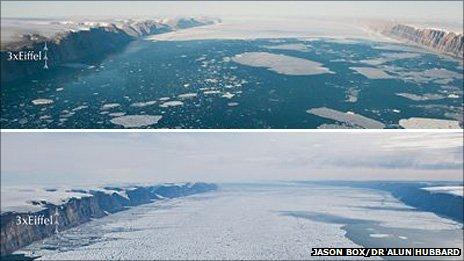'Gob-smacking' scale of Petermann Glacier break-up
- Published

These photos of the Petermann Glacier were taken two years apart, the latest one in July 2011 (top) and in the summer of 2009
New pictures have revealed the extent to which part of a huge glacier in northern Greenland has broken up in just two years, claims a glaciologist.
Dr Alun Hubbard of Aberystwyth University said he was "gob-smacked" by the scale of the Petermann Glacier's break-up since he last visited in 2009.
The glacier is 186 miles (300km) long and up to 3,280ft (1000m) high - three times the height of the Eiffel Tower.
Last year, it shed a piece of ice measuring 77 square miles (200 sq km).
Dr Hubbard has been researching the Greenland ice sheet for some years.
His team of researchers and scientists from Aberystwyth and Swansea universities have made several trips to the country.
Located in north west Greenland, the Petermann Glacier accounts for 6% of the area of the Greenland ice sheet, said Dr Hubbard.
It terminates as a floating tongue of ice, measuring around 43 miles (70km) long by 12 miles (20km) wide, the largest of its kind in the northern hemisphere.
At its thickest the glacier is 3,280ft (1000m) high.
"Although I knew what to expect in terms of ice loss from satellite imagery, I was still completely unprepared for the gob-smacking scale of the break-up, which rendered me speechless," said Dr Hubbard.
"It was incredible to see. This glacier is huge, 20km across and 1000m high.
"It's like looking into the Grand Canyon full of ice and coming back two years later to find it's full of water."
He said data recovered from global positioning system (GPS) sensors at the site was being analysed at Aberystwyth.
Cracks and rifts
With support from the US National Science Foundation and the Natural Environment Research Council in the UK, Dr Hubbard travelled by helicopter to the glacier to gather data from time lapse cameras and GPS sensors set up in July and August 2009, with the help of Greenpeace.
The GPS sensors were set in anticipation of a large break-up of ice that eventually occurred by on 3 August, 2010.
Dr Hubbard said this led to the formation of an ice island measuring more than 77 square miles (200 sq km).
He believes the cracks and rifts in what remains of the ice shelf means it is also likely to break up at some point in the near future.
Dr Hubbard visited the Petermann glacier at the end of July, and returned to Aberystwyth on Sunday.
His work is part of a wider project involving researchers from Bristol, Cambridge, Edinburgh, Denmark, Sweden, the Netherlands, Germany and the United States.
- Published29 December 2010